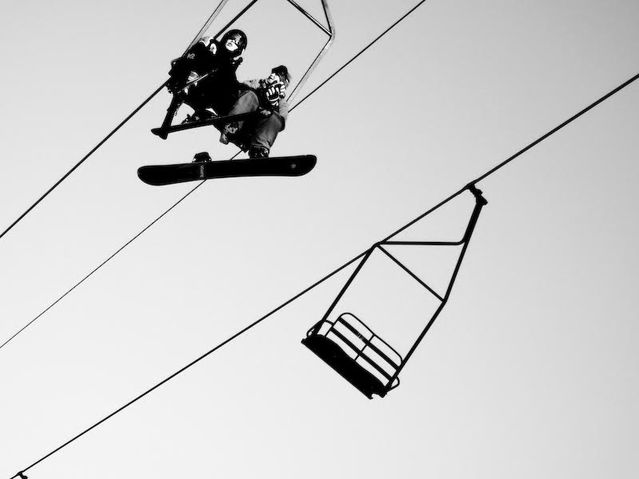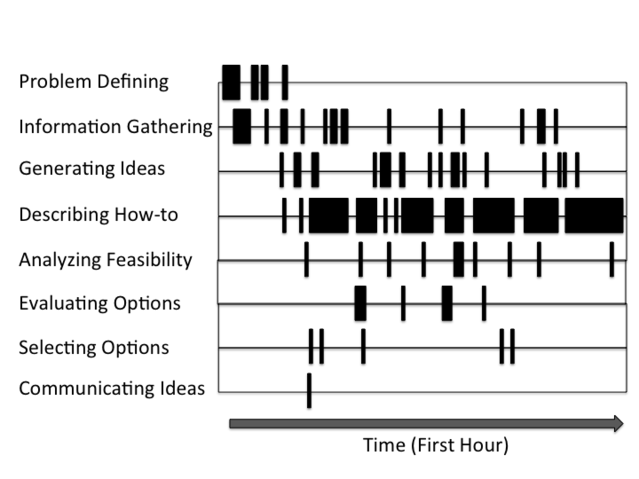
We often like to simplify things but –– let’s face it –– creativity is a messy business. It’s filled with trial and error, trying this and trying that. It reaches across time (minutes, hours, weeks or months, sometimes years) and space. It’s rife with unpredictable spurts forward and sudden stops or detours as unforeseen obstacles loom on the horizon. How then can we ever see “inside creativity” –– peering into this dynamically changing thinking-making process to learn what works well and what doesn’t?
One promising approach is to generate a sort of “creative micro-world” –– setting out a creative challenge that can be taken up in a somewhat limited period of time (say a few hours), with specific constraints and goals. Then the entire thinking-making process of creative designers or engineers can be observed (perhaps videotaped and audiotaped). The designers might also be asked to “think aloud” –– telling us, moment by moment, what they’re thinking, what problem they’re facing, what options they see, or what next steps they’re mentally testing out (or ruling out).
Such a “think aloud” approach was used by engineering and design professor Cynthia Atman and her colleagues in a classic 1999 study, to examine how engineering students creatively worked through the challenge of designing a neighborhood urban playground. The students were given several hours to design a playground for about 12 children between the ages of 1 and 10. Their design needed to meet a host of specifications and constraints regarding safety, cost, materials, etc., all while offering inviting play opportunities for young children of various ages and abilities. The students were asked to think aloud to the researchers as they worked through their emerging plans: sketching, jotting down notes, and making calculations.
Starting with preliminary ideas and trying to spell out how they might work, the students iteratively refined, elaborated, and revisited their original ideas, identifying problems and exploring possible solutions, looping back again and again to check their progress against the design goals.
Designers in the experiment who produced higher quality designs significantly more often varied their levels of abstraction throughout the design process. Higher quality designs were associated with “cascading” thinking processes that coursed through multiple levels of abstraction. This cascade involved patterns of iteratively thinking through the design problem, modeling, evaluating, clarifying, reflecting, noticing moves, and cycling back again.
In contrast, designers who got stuck at any one level for too long produced less creative designs that more often fell short of the basic project requirements.
A schematic diagram that captures the thinking processes of two students during only the first hour of their playground design is shown below. The final design of the first student achieved a low overall quality/creativity score. The second student though — who cycled and looped back to problem definition more often — was awarded a much higher overall quality/creativity score. What other differences in the ways of thinking and acting of the two students do you notice?


But what if we’d like to peer into more “real world” creative processes that extend over not hours but weeks or months, and that demand the combined collaborative efforts of a team?
Taking up this considerable challenge, a group of industrial engineering researchers at the University of Pittsburgh and Penn State recently decided to chart the creative thinking activities of teams of engineering students completing their senior capstone projects. Their 2015 paper analyzes data from thousands of design hours, across several months, from 26 student teams of between 3 to 5 people. Each team was charged with designing an actual working prototype for a new bioengineering device, such as an infant incubator for hospitals in developing countries.
Twice each week, each student was asked to complete an online survey indicating the types of project activities they had engaged in since the last prompt. The students were shown an extensive list of possible design activities, encompassing aspects of problem definition (such as clarifying objectives, establishing user requirements), conceptual design (generating design alternatives), preliminary design (modeling and testing conceptual designs), detailed design (refining and optimizing the chosen design), as well as design documentation, and market and management issues.
The final designs of each team were systematically assessed by experts on several innovation criteria, such as the novel use of materials, components, or production processes.
Contrasting the thinking processes of the eight most highly innovative teams and the eight least innovative teams, it was found that teams that produced highly innovative products differed from less innovative teams in multiple ways. Innovative teams spent more time on problem definition, both early and late in the multi-month process. The innovative teams repeatedly “circled back” to check that any problems or opportunities had been fully understood, and addressed. Innovative teams also focused more on both conceptual design (“back of the envelope” explorations of possible directions) and detailed design.
What can we learn from these two studies?
One key commonality across the studies is the importance of repeatedly cycling back to our creative goals and our “problem definition.” We need to ask ourselves, not once, but over and over again, throughout a creative endeavor: What exactly are we attempting to do? Is the path we’re embarking on one that will meet our creative goals, and effectively meet and embrace the various creative constraints we are facing? Are we overlooking some of the requirements of the “design brief” we’re given or have given ourselves? Are we over-emphasizing some aspects?
A second and related commonality across the two studies is the interleaving of thinking at both a conceptual (big picture) level with a more specific (detailed) level. Both the more creative individuals and the more innovative teams showed repeated loops back and forth between these levels of abstraction, with each informing the other. This is the essential creative process of what, in Innovating Minds: Rethinking Creativity to Inspire Change, we call “detail stepping.”
And so, why the image of the ski lift at the head of this post? Conceptual or abstract “big picture” thinking is analogous to taking a ski lift chair high up over the slopes. Through abstraction we travel effortlessly far above all the sculpted snowy dips and shallower contours. Yet we cannot ignore those same snowy dips and contours. They are at the very center of our exhilarating ski-borne (or snowboard-borne) journeys, without which there’d be no need or purpose for the lift…




